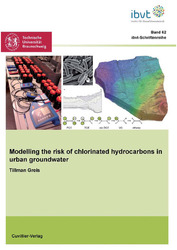| Fachbereiche | |
|---|---|
| Buchreihen (96) |
1378
|
| Nachhaltigkeit |
3
|
| Gesundheitswesen |
1
|
| Geisteswissenschaften |
2365
|
| Naturwissenschaften |
5406
|
| Mathematik | 229 |
| Informatik | 319 |
| Physik | 980 |
| Chemie | 1363 |
| Geowissenschaften | 131 |
| Humanmedizin | 243 |
| Zahn-, Mund- und Kieferheilkunde | 10 |
| Veterinärmedizin | 108 |
| Pharmazie | 147 |
| Biologie | 835 |
| Biochemie, Molekularbiologie, Gentechnologie | 121 |
| Biophysik | 25 |
| Ernährungs- und Haushaltswissenschaften | 45 |
| Land- und Agrarwissenschaften | 1004 |
| Forstwissenschaften | 201 |
| Gartenbauwissenschaft | 20 |
| Umweltforschung, Ökologie und Landespflege | 148 |
| Ingenieurwissenschaften |
1793
|
| Allgemein |
98
|
|
Leitlinien Unfallchirurgie
5. Auflage bestellen |
|
Erweiterte Suche
Modelling the risk of chloridnated hydrocarbons in urban groundwater (Band 62)
Tillman Greis (Autor)Vorschau
Inhaltsverzeichnis, Datei (44 KB)
Leseprobe, Datei (120 KB)
The main target of this work is the development of a risk assessment approach of groundwater contaminations in an urban area. A multidisciplinary approach was performed to assess degradation potential of contaminant species in soil and the inherent risk posed by anthropogenic substances. Experimental and theoretical methods range from chemical and biochemical to geoengineering applications. This especially concerns molecular biological, wet-chemistry techniques and Finite Element groundwater transport and reaction modelling. The spatial dimensions considered in the studies range from small laboratory to field scales. With regard to these applied methods the overall goal was a holistic risk approach to intertwine both, reactive transport of contaminants in groundwater and human health risks. An experimental area polluted with chlorinated ethenes and located in Braunschweig was chosen to validate the model. Based on repeated measurement campaigns pollutant concentrations as well as other environmental parameters and chemical data were determined and their quality was valued at assessed literature data. With the obtained experimental data a groundwater reactive transport model was established and validated. Further, to test the influence of the flow, transport and reaction model parameters a sensitivity analysis was performed. Based on this analysis, contaminant specific probabilities of occurrence were calculated with a Monte-Carlo simulation approach. Additionally, model optimisation techniques were applied to improve conformity of simulated and experimental data. It could be shown, that a simplified first-order reaction kinetic is only partially capable of rendering the measured field data. Hence, it was necessary to extend and improve the underlying degradation kinetics by means of modified Monod-equations. Here, the extension mainly comprises the introduction of inorganic electron acceptors as well as inhibiting reactions to refine the reductive dechlorination process of the chlorinated hydrocarbons. The next important step concerns the derivation of a health risk approach from the aforementioned concentration probabilities of occurrence. The combined model approach finally enables to calculate spatial and temporal health risk occurrence.
| ISBN-13 (Printausgabe) | 3869559705 |
| ISBN-13 (Printausgabe) | 9783869559704 |
| ISBN-13 (E-Book) | 9783736939707 |
| Buchendformat | A5 |
| Sprache | Englisch |
| Seitenanzahl | 153 |
| Umschlagkaschierung | matt |
| Auflage | 1 Aufl. |
| Buchreihe | Schriftenreihe des Institutes für Bioverfahrenstechnik der Technischen Universität Braunschweig |
| Band | 62 |
| Erscheinungsort | Göttingen |
| Promotionsort | Braunschweig |
| Erscheinungsdatum | 23.12.2011 |
| Allgemeine Einordnung | Dissertation |
| Fachbereiche |
Umweltforschung, Ökologie und Landespflege
|








